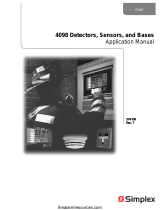Leaders in Life. Safety. Technology.
detection after the airflow has stopped (e.g. air conditioning switched
off) and the smoke takes its traditional vertical path toward the ceiling.
Should the protected areas be external (or an area with similar envi-
ronment such as an aircraft hanger that has large doors open), then
there would be no predictable airflow.
Other At Source Detection Methods
Besides VSD, other at source type detectors are:
1. Thermal Imaging Cameras
- These systems can detect changes
in temperature by monitoring infrared emissions. They can be useful
in a controlled environment where there are no other forms of unpre-
dictable heat sources. They are impractical areas where heat sources
such as people, cars and machinery are moving through the scene.
2. Image Processing of Heat Changes
- These systems work by
fitting a heat sensitive pad to known risk areas. These heat pads will
change color or contrast with the increase in temperature. This change
can then be monitored and processed via a thermal imaging camera.
3. Flame Detectors -
The most popular at source fire detection sys-
tems in this category are flame detectors. The difficulty with flame
detectors is that by the time flames appear to trigger the device into
alarm, serious fire damage has occurred and will rapidly increase; also
significant amounts of smoke may have been emitted causing serious
risks to personal health.
Video Smoke Detection Principle of Operation
VSD, first developed in the late 1990s, is based on sophisticated com-
puter analysis of the video image seen by a standard CCTV camera
(sensor). Using advanced image-processing technology and extensive
detection algorithms (and known false alarm phenomena), the VSD can
automatically identify the distinct characteristics of smoke and flame
patterns. The fire detection industry has an abundance of known
smoke and flame phenomena, such as frequency of flicker, and all of
these factors are built into the system to give an accurate decision on
whether smoke and/or flames are present. The VSD system is so accu-
rate in its analysis that it can differentiate between steam and smoke.
The VSD system uses standard CCTV cameras (back and white, color,
infrared, existing or new) linked to a self contained processing system
which is capable of recognizing small amounts of smoke and flame
patterns within the video image and alerting the system operator both
at the processor and by a variety of remote outputs.
The VSD system executes highly complex algorithms to process video
information from up to eight cameras simultaneously. Under normal
conditions with all eight cameras connected, the system achieves
a 5Hz-frame rate for each channel.
The VSD system detects smoke and flame rapidly by looking for
small areas of change within the image at the digitization stage and
only passing these pixel changes to the main processor for further
filtering.
The video information is passed through a series of filters that seek
particular characteristics associated with smoke and flame behavior.
Further analysis is then carried out on the relationships between the
filtered characteristics to determine whether all the conditions have
been met for the system to accurately predict the presence of smoke
and/or flame.
The video hardware is designed to allow simultaneous real time
digitizing of all eight images, which means that the system does
not multiplex images and therefore no information is lost or delayed.
All alarm condition images are log time and date stamped, and stored
within the system’s memory.
The system installer has the ability to vary the amount of smoke
signal, and the length of time that the smoke exists before an alarm
condition is raised to allow for situations where there may be back-
ground smoke present. The installer may also divide the video image
into zones and program the system to alarm only if smoke and/or
flame are present in two or more zones.
For even greater system performance, two camera images can be
associated together so smoke and/or flame in one image is to be
treated as a pre-alarm and smoke and/or flame in the second
camera image triggers a full alarm.
To compensate for areas of the image that could prove troublesome
such as reflective surfaces or smoke producing processes, the
installer or system user has the ability to eliminate or mask parts
of the image from detection on an individual pixel-by-pixel basis.
Benefits of Video Smoke Detection (VSD)
Quick Investigation and False Alarm Rejection
The ability of VSD to pinpoint the source of a fire on a camera monitor
lets an operator or security staff view the area affected and assess
the severity of the situation without delay. This can be done at a very
early stage to allow the operator to view the camera image after a
strobe or sounder is triggered locally and then take necessary action.
The ultimate evacuation of the building can be delayed to allow an
operator the time to verify and, if necessary, reject a false activation
before the fire alarm is sounded.
Detection Not Affected by Ceiling Height
VSD is especially effective in areas with high ceilings such as atria,
concert halls, railroad stations, etc. VSD cameras need only to be
mounted to see above the risk area, and this location generally
makes for ease of maintenance, initial camera mounting and
commissioning.





